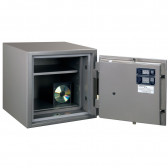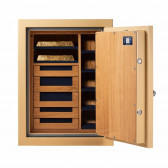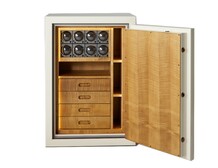When you're trying on a safe purchase, one of the components you'll come to choose is how to lock the safe. There are several options to choose from, which vary in terms of operation, price and comfort, but also in terms of the individual needs of the user. These are key lock, mechanical combination lock, electronic lock and biometric lock. Let's take a closer look at them.
Key lock
Opening the door to a safe with keys is the standard factory method of managing the safe. As a rule, you receive a set of two keys with the safe. The door is opened by turning the key and the handle is used for direct bolt control. The undoubted advantage of the key lock is its simplicity of use and price, as key locks are included in the cost of the safe. The troublesome side of this type of lock is the need to take care of the security of the keys. If they are lost, the procedure for making them up is expensive and lengthy, and you are not sure where the lost key is anyway.
Mechanical combination lock
Professional combination locks are devices that operate with movable, manually moved dials. The method of operation is familiar to anyone who has watched films about cashiers from between the wars, but these days a stethoscope and good hearing are no longer enough. Modern combination locks have systems that dampen any sound, making it very difficult to "feel" them. Combination locks are operated by turning a dial to set them in the right position. This technique has its fans, but requires concentration and precision, so it is mainly aimed at patient people who will use the safe occasionally and quietly. For this reason, locks opened in this way are not recommended for storing weapons for personal defence.
Electronic lock
Electronic locks are undoubtedly the most popular way to use a safe. The installation of electronic locks in the safe does not require the connection of cables, power is supplied by a 9V battery. User authentication takes place via a PIN code: a master code of 4-6 digits + an administrator code, which more professional combination locks are equipped with. Securing the safe's door by entering a code is a simple way to make the safe convenient to use. Codes or external devices are used for programming purposes. Electronic locks also have the advantage of a number of additional features, the most important of which are:
Silent alarm
Triggered by a special code – a useful solution if you are forced to open the door by an attacker. Yes, the safe will open, but at the same time the built-in relay will send a signal to the alarm system.
Audit of operations
The more sophisticated electronic locks allow precise management of access to the safe. The capacity of the memory allows operations to be recorded; in various versions, they can be read from an application on a computer or by entering a code.
Multiple users
An electronic lock usually allows access by password to multiple users. An electronic combination lock allows from 2 to several hundred users to be defined, each with their own individual code.
Biometric lock
For the most demanding users, we offer the option of locking access to the safe with a fingerprint reader. Biometric locks are a modern and proven access control, thanks to which the entire security level of the safe goes to a higher level. Please note that a mains power supply is required for such a lock.
Other options
There are also non-standard solutions on the market, such as locking the safe with an RFID card reader. It is worth remembering that a safe is only secure if both it and the lock have the appropriate certificate. Currently, proximity card locks do not have burglary protection classes. The same applies to remote access to the safe. Standalone lock operation, in which the system allows the lock to be opened remotely, is not recommended as the only access control. This type of security can be used on the door to the room where the safe is located, but the entire system must include a combination lock or electronic lock that is suitable for the safe.
What will be the best lock?
Given our many years of experience with safes, we can confidently say which products are the most popular choice and why. It is fair to say that most customers prefer to enter a pin code instead of inconvenient keys. Entering the safe using a mechanical combination lock has its enthusiasts, but they can be counted on the fingers of one hand on an annual basis. Likewise with a biometric lock. Electronic code locks are the most common choice, but does that mean they are the best? They are certainly the easiest to use, the most intuitive and allow the most options, even in private homes. However, the choice of lock, like the choice of the entire safe, depends entirely on individual needs.
You may be interested in: Keyed or electronic lock. Which lock to choose for a safe?
Operating instructions for a safe equipped with various types of locks
Electronic lock for the safe – everything you need to know about it






